How much time should
be spent on Conditioning? |
No less than one quarter of a training session but no more
than 30 minutes in total e.g.
- 1 hour training - 15 minutes of conditioning
- 2 hour training - 30 minutes of conditioning
- 3-4 hours training - 30 minutes of conditioning
|
| |
Exercises to Develop Fitness & Conditioning |
To Start: |
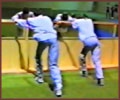 |
1) Stretching the calf muscle - Make sure that the back heal is on the ground and that the angle of the frount knee is not forward of the foot.
|
| |
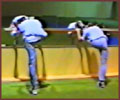 |
2) Stretching the hamstring muscles - With one foot raised on a table, box or barre, slowly lean chest forward towards the top of the leg. Make sure the hips are not twisted and foot of supporting led is facing forward.
|
| |
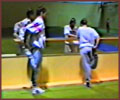 |
3) Stretching the thigh - make sure knees are togeather and leg is not twisted to the side. |
| |
Aerobic Activities: |
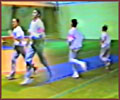 |
1) 10-15 miunutes of Jogging (after 6 months some short sprints can also be performed) |
| |
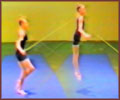 |
2) Skipping with single and double turns of the rope. |
| |
Specific Exercises: |
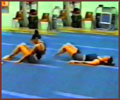 |
1) Roll-ups:
Head rolls up first, fingers stay in
contact with the floor and feet remain flat on the floor.
Start with 5 repititions, no more than 25. Make sure the exercise is done slowly.
|
| |
 |
2) Tuck-jumps:
- zig zag across mat
- knees tucked high in frount
- giant hops across on right foot
- giant hops across on left foot
|
| |
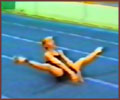 |
3) Straddle situps:
Start lying on floor on back with legs stait up in the air, as you straddle your legs, bring chest towards legs into a half sitting position (as in picture), make sure legs are strait, and back is keps rounded.
|
| |
 |
4) Jumps onto box:
Boxes can be varying heights
according to the foot and leg strength of the gymnast.
Aim for a maximum of 15 jumps. Keep laegs togeather, chest fairly horizontal, and lift knees high.
|
| |
 |
5) Roll over and pike:
keep legs togeather
and off the floor, body tight. Start with 5 repetitions,
no more than 10. (One repetition is roll left and pike,
roll right and pike.)
|
| |
 |
6) Jumps:
Side to side with small tucks and neat
feet. Repetitions (jump in, jump out, in, out) start
with one, no more than 10.
|
| |
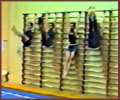 |
7) Leg lifts from wall bar:
5-10 repetitions, make sure legs are kept strait, and that the exersise is done slowly to ensure the legs are lifted, and not swung. For younger gymnasts, aim to lift legs to horizontal.
|
| |
 |
8) Tuck jumps on crah mats: 10 jumps then rest,
repeat 4 times. Keep feet togeather and lift knees to chest.
|
| |
 |
9) Calf rises:
Rise up on to toes, and back down to the floor. Exercise should be done slowly, and can be done on both or one foot.
|
| |
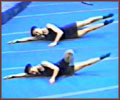 |
10) Side leg lifts:
Can be done with one or both legs. Make sure body is on side and not twisting
|
| |
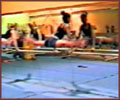 |
11) Split jumps at barre:
Good ankle exercise for injury prevention as well elevation and amplitude for split leaps. Can be done on left and right legs, as well as side. Keep legs strait and toes pointed.
|
| |
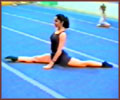 |
12) Final stretch:
Be careful to maintain correct
hip placement.
|
| |
|
The information in this section has been taken from
the Australian Gymnastics Levels Program for RG
by the Australian Gymnastic Federation Inc.
The screen grabs are from the National stream, levels 1-6 video (1997-2000), available from the Australian Gymnastic Federation.
|